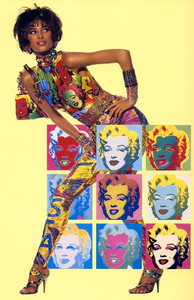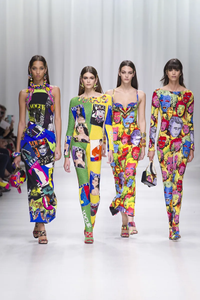When Art and Fashion Unite! Collabs and More!
- Gaby Camargo
- Jan 17
- 4 min read
Fashion is the art we wear every day, and great masterpieces often leave their mark on the runway. The relationship between art and fashion is both historical and ongoing, as they are creative forms of expression that reflect culture, the spirit of the times, and even a person’s identity, personality, and tastes. These two worlds always go hand in hand, forging a deep connection between creativity and self-expression.
While art captures emotions, ideas, and historical moments on canvas and in sculptures, fashion transforms them into wearable pieces we can display daily. Over the years, designers have drawn inspiration from artistic movements and iconic works to create unique designs, reinforcing the idea that fashion is, indeed, art. In this post, I’ll show you the greatest collaborations between designers and artists and how art inspires fashion!
The Connection Between Art & Fashion
Fashion and art have always influenced each other throughout history, reflecting the social and cultural changes of their time. During the Renaissance, for example, clothing was inspired by artistic representations. In the 20th century, movements like Surrealism, Cubism, Pop Art, and Impressionism had a major influence on the design of accessories and garments.

Artists and designers play a crucial role in shaping trends. Designers often draw inspiration from artists and their works when creating a collection, while artists, in addition to capturing emotions and ideas on canvas and in sculptures, can also be influenced by the world of fashion. This continuous cycle between fashion and art allows both forms of expression to evolve creatively, resulting in pieces that are both functional and artistic manifestations.
Collabs Between Designers and Artists
There have been many collaborations between designers and artists throughout history. Here, I’ll showcase the most popular ones in chronological order!
1937: Elsa Schaparelli and Salvador Dalí
In 1937, Elsa Schiaparelli designed an off-white silk evening gown in an A-line silhouette, featuring a crimson waistband and a lobster painted by Salvador Dalí, printed onto the dress by silk designer Sache. Starting in 1934, Dalí began incorporating lobsters into his work, including the famous Lobster Telephone (1936). Dalí viewed lobsters as a symbol of sensuality. Elsa Schiaparelli was one of Coco Chanel's main rivals at the time, and when she introduced this dress, it stood out as completely different from Chanel's style.
1965: Yves Saint Laurent and Piet Mondrian
This is one of the most famous collaborations between artists and designers. The haute couture dress collection called Mondrian featured trapeze dresses with Mondrian's iconic pattern of black lines and blocks of primary colors (red, blue, and yellow) interspersed with white spaces.
1991: Versace and Andy Warhol
This collab took place during the Fall/Winter 1991 collection under the creative direction of Gianni Versace. The collection became iconic for its colorful and vibrant Pop Art prints, bringing Andy Warhol's famous portraits into the world of fashion.
2002: Castelbajac + Keith Haring

In 2002, designer Jean-Charles de Castelbajac incorporated the signature style of Keith Haring, one of the most iconic artists in street art and pop culture, into his collection. Known for his playful and artistic approach, Castelbajac integrated Haring's work into coats, dresses, and accessories, creating a perfect fusion of urban art and haute couture.
2007: Galliano para Dior + Rothko, Monet e Degas
In 2007, while still the creative director of Dior, John Galliano presented a haute couture collection that paid homage to artists Mark Rothko, Claude Monet, and Edgar Degas. Galliano drew inspiration from Rothko's iconic color blocks to design bold and striking dresses. He also featured gowns inspired by Monet's impressionist landscapes, particularly those of Giverny. Degas’ ballerinas were translated into delicate tulle dresses with voluminous, ethereal skirts, capturing the grace and elegance of his work.
2009: Kriemler to Akris and Monet

In 2009, Albert Kriemler, designer for the Swiss brand Akris, presented a collection inspired by Claude Monet's iconic works, specifically his paintings of the gardens at Giverny. Kriemler used Monet's famous depictions of lotus flowers and water bridges as the central prints, applying them subtly and modernly to dresses, blouses, and coats. The palette was dominated by soft shades of green, blue, lilac, and pink, evoking the serene beauty of Monet's masterpieces.
2012: Louis Vuitton and Yayoi Kusama
In 2012, Louis Vuitton launched an iconic collaboration with Japanese artist Yayoi Kusama, renowned for her works featuring polka dot patterns and psychedelic themes. Polka dots dominated the collection, appearing on clothing, handbags (including the Louis Vuitton Speedy and Neverfull), shoes, and accessories in bold colors like red, blue, yellow, and white. This vibrant partnership seamlessly blended Kusama's artistic vision with Louis Vuitton's timeless designs.
2014: Sportmax and Pollock

In 2014, Sportmax, a luxury brand under the Italian Max Mara group, launched a collection inspired by the work of Jackson Pollock, one of the leading figures of the Abstract Expressionist movement. The collection featured Pollock's iconic drip painting techniques, presented in neutral tones like black, white, and beige, along with accents of more vibrant colors.
2020: Jeremy Scott and Picasso

In 2020, Jeremy Scott, the creative director of Moschino, launched a collection inspired by the works of the legendary Spanish painter Pablo Picasso. This Spring/Summer collection fused fashion, art, and theater, showcasing Picasso's most iconic artistic phases, such as Cubism and his Blue and Rose periods.
Fashion as Living Art
Fashion is undoubtedly one of the most dynamic, accessible, and influential forms of art. While paintings and sculptures are typically static, fashion is a "living" art form, constantly evolving and reflecting people's personal identities. Unlike other forms of art that remain "fixed," fashion is always in motion, adapting to trends that emerge and fade in just days. Each runway collection is an evolution of what came before, with art and culture playing a major role in shaping the future of fashion.





































Comments